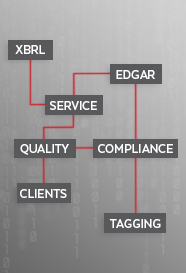Layman’s terms of what should be done to assure quality in XBRL filings:
1. Unless you have years of XBRL tagging and taxonomy expertise in your financial reporting group, a software solution or web filing solution will probably not offer you enough support for quality assurance with regard to the technical and subjective portions of XBRL.
2. There is no one-size-fits-all approach to designing a quality XBRL filing. Regardless of limited liability protection, each company should manage XBRL risks within its risk appetite, define a comprehensive process to identify all the sensitive areas events, and make sure the company utilizes a provider with a clear XBRL quality assurance framework.
3. Since the SEC does not indicate any requirement of audit of XBRL documents, most auditing houses do not provide XBRL tagging services and they are not the experts in taxonomy creation or XBRL creation software. In fact, the SEC specifically omits auditors from having to offer certification of XBRL documents.
4. Companies need to focus on the quality of their reporting as soon as possible. There should be a full review of the tags used by both automated checks and by a person familiar with your XBRL tagging, and with expertise and understanding of your industry. This person should not be completely objective to the taxonomy creation because there are several ways to present XBRL information depending on the circumstance/situation at hand. Even more confusing to a machine is the fact that each of the variations can be compliant with the SEC.
5. Validate the document for completeness and structure, independently, irrespective of whether the document is built in-house or outsourced to an XBRL service provider/ printers.
6. Have a communication record between your team and a way of tracking what improvements and changes were made quarter over quarter, and most importantly, why they were made. This is what will matter. From our own experience in this matter, it helps to have a person involved because computers are not good at explaining themselves to a group or the SEC.
7. In the absence of formal SEC guidance, it is important to establish a policy to assess material XBRL errors and a process to determine whether an amendment filing is required.
8. If you are planning on maintaining control internally, your company should stay current with the latest approved XBRL taxonomy. Upon each release that has been approved by FASB and the SEC (typically between February and May each year), your team should compare and utilize the newest version to the previous version used and look for areas of improvement.
9. Stay abreast of all FASB guidance, SEC staff observations, regulations and the current AICPA exposure draft on XBRL quality attributes. Avoid last-minute surprises by being aware of the latest developments and best practices from the SEC and XBRL US.
10. As XBRL reporting standards and taxonomies evolve, monitoring the changes above is crucial to a continued quality assurance in your company’s filing.



